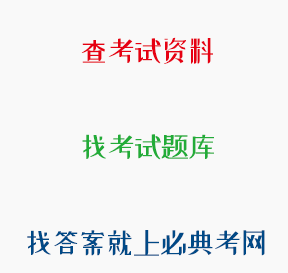正确答案: B
Writing a party invitation to your friends.
题目:Which of the following is a communicative task?
解析:本题考查课堂活动。题干:以下哪个选项属于交际性任务?A项“朗读第24页的对话”,B项“给你的朋友写一封聚会邀请函”,C项“将第一段翻译成汉语”,D项“用所给短语造句”。communicative task是指在各种形式的交际性活动中学生完成的目标任务,即真实的交际性任务,以实现真正运用语言。A.C.D三项的任务都没有放在真实的交际语境中,故本题选B。
查看原题 查看所有试题
学习资料的答案和解析:
[单选题]下列学习理论中,学生观强调引导儿童从原有的知识经验中"生长"出新的知识经验的是( )。
建构主义学习理论
解析:建构主义学习理论主张认识和学习是表征和反映真实客观事实的过程,注重学习者的内部过程,包括对新信息的意义建构和对原有经验的改造和重组。建构主义理论中有两个关键词,即"建构"和"生长"。
[多选题]劳动技术教育就是组织学生参加生产劳动。( )
解析:劳动技术教育是向学生传授现代生产劳动知识和生产技能,培养学生正确的劳动观点,养成良好劳动习惯的教育。劳动技术教育的主要任务包括培养学生良好的劳动品质:使学生掌握现代生产基本原理与基本生产技术知识和某种职业技术知识;通过劳动技术教育实践,增强体质,陶冶审美的情趣,促进学生身心的健康发展,并注意在劳动中培养学生观察、思维、想象的能力和创造精神。从劳动技术教育的定义和内容上可以看出,组织学生参加生产劳动只是劳动技术教育的途径之一。
[单选题]对教育的等级化、特权化和专制化予以否定的现代教育特征是( )。
教育的民主化
解析:教育民主化是对教育的等级化、特权化和专制型的否定,故选择A。B选项,教育的多元化,具体表现为培养目标的多元化、办学形式的多元化、管理模式的多元化、教学内容的多元化、评价标准的多元化等。C选项,教育的终身化是适应科学知识的加速增长和人的持续发展要求而逐渐形成的一种教育思想和教育制度。D选项,教育的全民化,全民教育是指教育必须面向所有的人,即人人都有接受教育的权利,且必须接受一定程度的教育。
[单选题]"吾十有五而志于学,三十而立,四十而不惑,五十而知天命,六十耳顺,七十而随心所欲,不逾矩。"这段话体现出的教育思想是( )。
终身教育
解析:我十五岁立志于学习,三十岁能够自立,四十岁能不被外界事物所迷惑.五十岁懂得了天命,六十岁能正确对待各种言论,不觉得不顺,七十岁能随心所欲而不越出规矩。这体现的是终身教育思想。
[单选题]短时记忆的容量有限,一般只能存储七个左右的信息项目,如要保持信息,就得采取( )。
复述
解析:短时记忆通过复述能够进入长时记忆,信息从而得到保持。
[单选题]Passage 1
Today's adults grew up in and economic system. The amount of time available to learn was fixed: one year per grad amount learned by the end of that time was free to vary: some of us learned a great deal;some, very little. As we advanced through the grades,those who had learned a great deal in previous grades continued to build on those foundations. Those who had failed to master the early prerequisites with in the allotted time failed to learn that which followed. After 12 or 13 years of cumulative treatment of this kind, we were, in effect, spread along an achievement continuum that was ultimately reflected in each students rank in class upon graduation.
From the very earliest grades, some students learned a great deal very quickly and consistently scored high on assessments. The emotional effect of this was to help them to see themselves as cap-able learners, and so these students became increasingly confident in school. That confidence gave them the inner emotional strength to take the risk of striving for more success because they believed that success was within their reach. Driven forward by this optimism, these students continued to try hard, and that effort continued to result in success for them. they became the academic and emotional winners. Notice that the trigger for their emotional strength and their learning success was their perception of their success on formal and informal assessments.
But there were other students who didn't fare so well. They scored very low on tests, beginning in the earliest grades. The emotional effect was to cause them to question their own capabilities as learners. They began to lose confidence, which, in turn, deprived them of the emotional reserves needed to continue to take risks. As their motivation warned, of course, their performance plummeted These students embarked on what they believed to be an irreversible slide toward inevitable failure and lost hope. Once again, the emotional trigger for their decision not to try was their perception of their performance on assessments.
Consider the reality--indeed, the paradox--of the schools in which we were reared. If some students worked hard and learned a lot, that was a positive result, and they would finish high in the rank order. But if some students gave up in hopeless failure, that was an acceptable result, too, because they would occupy places very low in the rank order. Their achievement results fed into the implicit mission of schools: the greater the spread of achievement among students, the more it rein-forced the rank order. This is why, if some students gave up and stopped trying(even dropped out of school) that was regarded as the students problem not the teachers or the school's.
Once again, please notice who is using test results to decide whether to strive for excellence or give up in hopelessness. The "data-based decision makers"in this process are students themselves Students are deciding whether success is within or beyond reach, whether the learning is worth the required effort, and so whether to try or not. The critical emotions underpinning the decision making process include anxiety, fear of failure, uncertainty, and unwillingness to take risks all triggered by students' perceptions of their own capabilities as reflected in assessment results.
Some students responded to the demands of such environments by working hard and learning a great deal. Others controlled their anxiety by giving up and not caring. The result for them is exactly the opposite of the one society wants. Instead of leaving no child behind, these practices, in effect,drove down the achievement of at least as many students as they successfully elevated. And the evidence suggests that the downside victims are more frequently members of particular socioeconomic and ethnic minorities.
Passage 1
What is the author 's attitude towards the old mission of assessment?
Negative
解析:作者在第二、三段分别阐述了学校的评估对于学习好的学生和学习不好的学生的情感效应,即学习好的学生越来越积极,学习不好的学生越来越消极。第四段提到即使学生成绩不好甚至辍学,这也被认为是学生自己的问题,而不是学校或教师的责任。作者的观点是学校不该让学生越来越消极。通过整篇的用词诸如最后一段“the downside victims”等可知,作者对于学校1日的评估工作是持消极态度的。故选择C。
[单选题]情绪的信号功能是通过表情来实现的。( )A.正确B.错误
解析:情绪和情感具有传递信息、沟通思想的功能。情绪和情感都有外部的表现,这就是表情。情绪和情感的信号功能是通过表情来实现的,如微笑表示友好。故本题是正确的。
[单选题]在小学教育教学实践中,教师运用多种方法进行反思。下列属于教师反思方法的( )。
教学日志
解析:教师反思方法有教育日志、教育案例、教育叙事、教后记、网络教研等。故选择A。
[单选题]从个体的素质构成出发,思想品德教育主要包括( )。
政治教育、思想教育、道德教育、法纪教育
解析:新时期学生的思想品德素质的内容应该包括政治、思想、道德和民主法制四个方面。故选择B。虽然也有版本说包括政治、思想、道德、民主法制和心理健康教育五个,但是前者是主流版本。故优先选择B。

 川公网安备 51012202001360号
川公网安备 51012202001360号